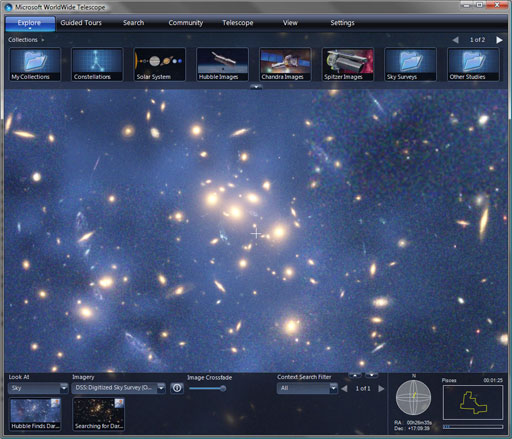Are Microsoft and Google in a space race? We think they are. Their rivalry is also, we believe, a precursor to the next great post-Internet technology boom: space exploration and development.
Microsoft released its new Worldwide Telescope this spring, which will access images from NASA's great fleet of space-born telescopes and earth-bound observatories such as the future Large Synoptic Survey Telescope, partially funded by Microsoft founder Bill Gates, which is projected for 'first light' in 2014 in Chile's Atacama Desert -the world's Southern Hemisphere space-observatory mecca. The 8.4-meter telescope will be able to survey the entire visible sky deeply in multiple colors every week with its 3-billion pixel digital camera. The telescope will probe the mysteries of dark matter and dark energy, and it will open a movie-like window on objects that change or move rapidly: exploding supernovae, potentially hazardous near-Earth asteroids and distant Kuiper Belt objects.

LSST is truly an Internet telescope, which will put terabytes of data each night into the hands of anyone that wants to explore it. The 8.4-metre LSST telescope and the 3-gigapixel camera are thus a shared resource for all humanity - the ultimate network peripheral device to explore the universe.
Not to be outdone, Google early this spring joined MIT scientists who are designing a satellite-based observatory -the Transiting Exoplanet Survey Satellite (TESS)- that they say could for the first time provide a sensitive survey of the entire sky to search for earth-like planets outside the solar system that appear to cross in front of bright stars. Google will fund development of the wide-field digital cameras needed for the satellite.
"When starships transporting colonists first depart the solar system, they may well be headed toward a TESS-discovered planet as their new home," says George R. Ricker, senior research scientist at the Kavli Institute for Astrophysics and Space Research at MIT.
Microsoft's new free software application called WorldWide Telescope allows everyone from space novices to astronomy professionals to easily explore galaxies, star systems and distant planets.
The WorldWide Telescope links together 12 terabytes -- the data equivalent of 2.6 billion pages of text -- of pictures from sources including the Hubble Space Telescope, the Chandra X-Ray Observatory Center and the Spitzer Space Telescope.
The experience is similar to playing a video game, allowing users to zoom in and out of galaxies that are thousands of light years away. It allows seamless viewing of far-away star systems and rarely-seen space dust in breathtaking clarity.
Microsoft said it will release the WorldWide Telescope free of charge as a tribute to Jim Gray, a Microsoft researcher who went missing off the coast of California while sailing last year. Gray worked on projects with astronomers to organize the vast amounts of data and images being pulled from satellites.
Google has a similar offering called Google Sky, a companion to its Google Earth program.
Features of WorldWide Telescope include virtual tours of different parts of space, led by expert educators and astronomers. People will be able to use the Microsoft program to create their own space tours, to share with their friends. The program is also notable for its high level of detail, its large volume of data and the ability to fine-tune the views, said Curtis Wong, principal researcher in Microsoft's Next Media Research Group.
"I expect that there are going to be a lot of people learning so much more about the sky, because we've taken away the limitations of light pollution and smog and bad weather," Wong said. "Those of us in Seattle, it's our chance to finally see the sky."
The program runs on the PC desktop but pulls data and images from the Internet. Google Sky can run in a standard Web browser or in the downloadable Google Earth program. But the system requirements for Microsoft's WorldWide Telescope program come with a catch: It works only in Windows XP or Windows Vista.
A test version of the software is available for download [
HERE].
Reader Comments
to our Newsletter